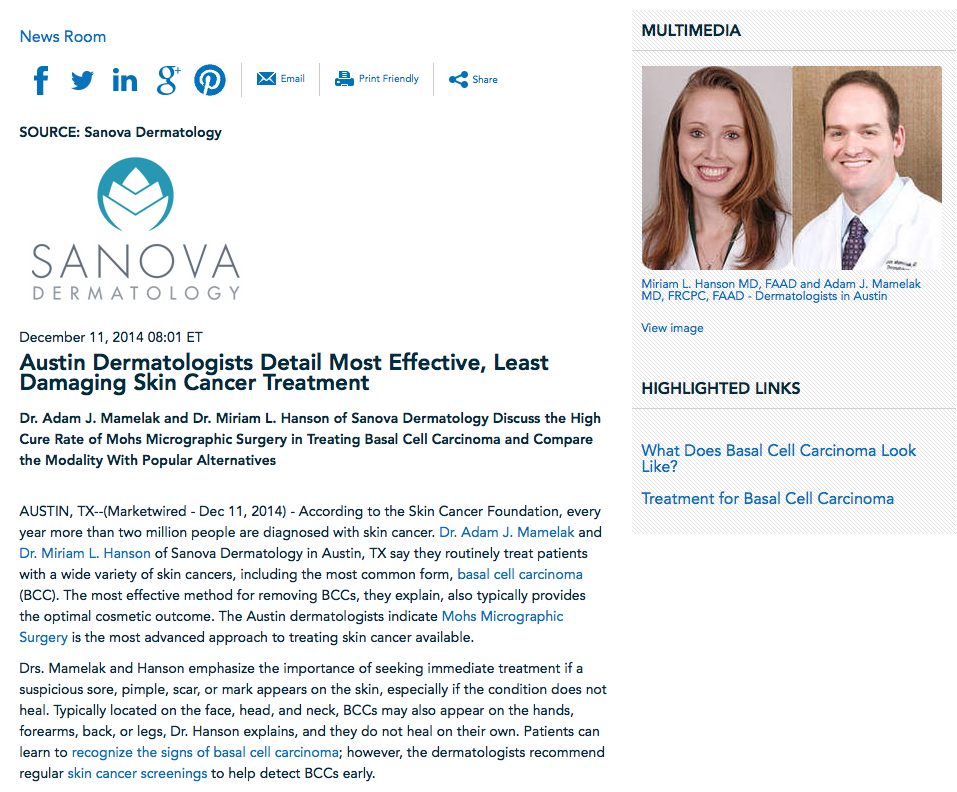
Dr. Adam J. Mamelak and Dr. Miriam L. Hanson of Sanova Dermatology discuss the high cure rate of Mohs Micrographic Surgery in treating Basal Cell Carcinoma and compare the modality with popular alternatives.
Austin, TX—According to the Skin Cancer Foundation, every year more than two million people are diagnosed with skin cancer. Dr. Adam J. Mamelak and Dr. Miriam L. Hanson of Sanova Dermatology in Austin, TX say they routinely treat patients with a wide variety of skin cancers, including the most common form, basal cell carcinoma (BCC). The most effective method for removing BCCs, they explain, also typically provides the optimal cosmetic outcome. The Austin dermatologists indicate Mohs Micrographic Surgery is the most advanced approach to treating skin cancer available.
Drs. Mamelak and Hanson emphasize the importance of seeking immediate treatment if a suspicious sore, pimple, scar, or mark appears on the skin, especially if the condition does not heal. Typically located on the face, head, and neck, BCCs may also appear on the hands, forearms, back, or legs, Dr. Hanson explains, and they do not heal on their own. Patients can learn to recognize the signs of basal cell carcinoma; however, the dermatologists recommend regular skin cancer screenings to help detect BCCs early.
BCCs are rarely dangerous, explains Dr. Mamelak, although they potentially can cause disfigurement. Fortunately, he explains there is a broad array of treatments for basal cell carcinoma, including topical, oral, and surgical methods. While each approach has its benefits, he states that Mohs Micrographic Surgery is by far the most effective and least damaging option for qualified patients. A trained Mohs surgeon, Dr. Mamelak details why he typically prefers this method, saying, “Mohs Surgery is an extremely precise tissue sparing procedure that allows for exceedingly high cure rates and also optimizes cosmetic outcomes.”
Since BCCs grow in a contiguous manner, Dr. Mamelak explains, all the tumor cells are connected. Therefore, he says he can precisely map the roots and growth pattern of the cancer cells with a microscope in order to fully remove them. Mohs Micrographic Surgery for basal cell carcinoma can offer individuals reassurance and relief, he suggests, due to the speed and efficacy of the procedure. “After only a few hours, a patient can go home knowing that there is a less than one percent chance of their cancer ever coming back.”
Ultimately, Drs. Mamelak and Hanson strive to help patients diagnose and treat BCCs before they pose a significant risk to their health, functionality, and quality of life. Mohs Micrographic Surgery is the most advanced treatment method for this common condition and can often outperform all other modalities, Dr. Mamelak states. “[Mohs] has significantly higher cure rates, obliviates the need for general anesthesia or multiple treatment visits, has little downtime and/or recovery, minimizes scarring, and produces superior cosmetic results.”
About Sanova Dermatology
Based in Austin, TX, Sanova Dermatology is directed by double board-certified dermatologist and Mohs surgeon Adam J. Mamelak, MD and board-certified dermatologist Miriam L. Hanson, MD. The state-of-the-art practice is dedicated to providing a comprehensive selection of the most advanced skin cancer and cosmetic dermatology procedures available, including Mohs Micrographic Surgery, reconstructive surgery, dermal fillers, and acne treatments. Furthermore, the dermatologists aspire to the principles of compassion, reliability, and exceptional results. Dr. Mamelak and Dr. Hanson are available for interview upon request.
For more information about Dr. Mamelak, Dr. Hanson, and Sanova Dermatology, please visit sanovadermatology.com, facebook.com/sanovadermatology, or twitter.com/DrAdamMamelak.
Contact:
Sanova Dermatology
Plaza North Building
12319 North Mopac Expy., Ste. 100
Austin, TX 78758
(512) 837-DERM (3376)
Rosemont Media
(858) 200-0044
www.rosemontmedia.com

